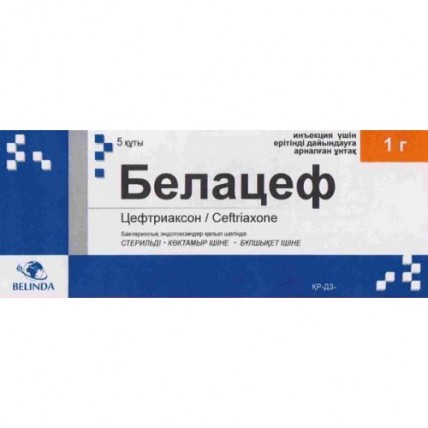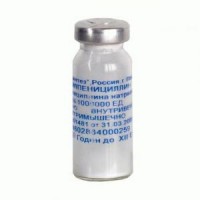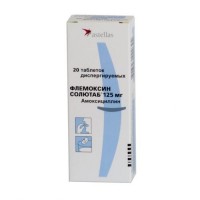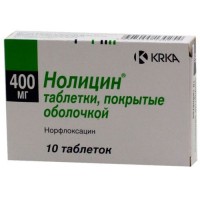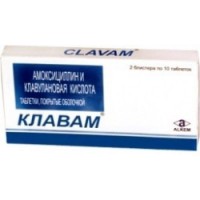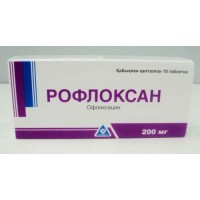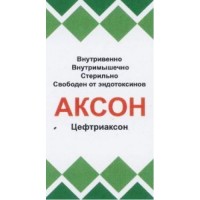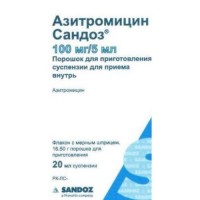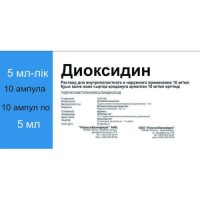Belatsef 5's 1g powder for solution for injection
- $59.20
The instruction for medical use of Belatsef Torgovoye medicine a name Belatsef Mezhdunarodnoye the unlicensed name Tseftriakson Lekarstvennaya a form Powder for preparation of solution for injections of 1 g. The structure One bottle contains active agent - a tseftriakson of sodium of 1.193 g (it is equivalent to a tseftriakson of 1.000 g) the Description Powder of color, white or white with a yellowish shade, Pharmacotherapeutic group Antimicrobial drugs for system use. Antibacterial drugs for system use. Beta laktamnye antibacterial drugs other. Cephalosporins of the third generation. Tseftriakson the ATX J01DD04 Code the Pharmacological Pharmacokinetics Pharmacokinetics properties of a tseftriakson has nonlinear character. All key pharmacokinetic parameters based on the general concentration of drug except for elimination half-life, depend on a dose. The maximum concentration in blood plasma after single intramuscular introduction of 1 g of drug makes about 81 mg/l and is reached within 2-3 hours after introduction. The area under a curve concentration in plasma – time after intravenous and intramuscular administration is identical. It means that the bioavailability of a tseftriakson after intramuscular introduction is 100%. The volume of distribution of a tseftriakson is 7-12 l. Tseftriakson reversibly contacts albumine. Linking with proteins of plasma makes about 95% at concentration in plasma lower than 100 mg/l. Communication is saturable and decreases with concentration growth (up to 85% at concentration in plasma of 300 mg/l). Thanks to smaller concentration of albumine in an intercellular lymph, the share of a free tseftriakson in it is higher, than in plasma. Tseftriakson is not exposed to system metabolism, but will be transformed to inactive metabolites in indestinal flora. After introduction in a dose of 1-2 g, tseftriakson well gets into fabrics and liquids of an organism. More than 24 hours its concentration much more exceeds the minimum overwhelming concentration for the majority of causative agents of infections in the majority of fabrics and liquids of an organism (in lungs, heart, bilious ways, a liver, tonsils, a middle ear, mucous a nose, bones and also spinal, pleural and synovial liquids and a secret of a prostate). After intravenous administration, tseftriakson quickly gets into cerebrospinal fluid (SMZh) where bactericidal concentration concerning sensitive microorganisms remain within 24 hours. The peak of concentration of a tseftriakson in SMZh is reached approximately in 4-6 hours after an intravenous injection. Concentration of a tseftriakson in cerebrospinal fluid at patients with bacterial meningitis, makes up to 25% of plasma levels (in comparison with 2% level of at patients with an uninflammed meninx). Tseftriakson gets through the inflamed meninx at children, including newborns. In 24 hours after intravenous administration in a dose of 50-100 mg/kg of body weight (newborns and babies) the concentration of a tseftriakson in cerebrospinal fluid exceeds 1.4 mg/l. The maximum concentration in cerebrospinal fluid is reached approximately in 4 hours after intravenous administration and makes, on average, 18 mg/l. In bacterial meningitis the average concentration of a tseftriakson in cerebrospinal fluid makes 17% of concentration in plasma, in aseptic meningitis - 4%. At adult patients with meningitis in 2-24 hours, after introduction of a dose of 50 mg/kg of body weight, concentration of a tseftriakson in cerebrospinal fluid many times over exceeds the minimum overwhelming concentration for the most widespread causative agents of meningitis. Tseftriakson passes through a placental barrier and in small concentration gets to breast milk. The plasma clearance of the general tseftriakson (connected and untied) is 10 - 22 ml/min. The renal clearance is 5 - 12 ml/min. of 50 - 60% of a tseftriakson is removed in not changed view with urine, mainly by glomerular filtration, and 40 - 50% are removed in not changed view with bile. Elimination half-life of a tseftriakson at adults makes about 8 hours. The pharmacokinetics at special groups of patients At patients with renal or hepatic dysfunction, even at patients with heavy renal failures, pharmacokinetics of a tseftriakson changes slightly with a little raised (less, than twice) a half-life period. Rather insignificant increase in elimination half-life in a renal failure is explained by compensatory increase it due to extrarenal clearance. At patients with an abnormal liver function, elimination half-life of a tseftriakson does not raise, in connection with compensatory increase in renal clearance. It is also connected with increase in the plasma free fraction of a tseftriakson promoting paradoxical increase in the general clearance of drug with increase in volume of redistribution. Patients are more senior than 75 years At elderly people 75 years average elimination half-life usually two-three times more long, than at young adults are more senior. Children the Half-life period of a tseftriakson is increased at newborn children. From the birth to 14-day age, levels of a free tseftriakson can increase in addition because of such factors as decrease in glomerular filtration and disturbance of linking with proteins. Children have a half-life period less, than at newborn and adult patients. At newborns, babies and children the plasma clearance and volume of distribution of a tseftriakson is higher, than at adults. The pharmacodynamics Tseftriakson suppresses synthesis of a bacterial cell wall after binding about penicillin - binding proteins. As a result biosynthesis of a cell wall (peptidoglikan) stops that leads to destruction and death of a bacterial cell. Tseftriakson possesses a broad spectrum of activity concerning gram-negative and gram-positive microorganisms, vysokoustoychiv to the majority β-лактамаз (as penicillinases, and tsefalosporinaz), developed by gram-positive and gram-negative bacteria. Resistance of bacteria to a tseftriakson can be connected with one or several of the following mechanisms: • hydrolysis beta laktamaz, including at an expanded range beta laktamaz, karbapenemaz and AmpC C enzymes which can be induced or be constantly activated in some aerobic gram-negative bacteria • decrease in affinity penicillin - the connecting proteins to a tseftriakson • impermeability of an outer membrane of gram-negative microorganisms. Tseftriakson is usually active concerning the following following microorganisms Gram-positive aerobes of Streptococcus pyogenes (Group A), Streptococcus agalactiae (Group B), Streptococcus pneumoniae, Viridans Group Streptococci, Staphylococci coagulase-negative (methicillin-susceptible) of £, Staphylococcus aureus (methicillin-susceptible). £ Gram-negative aerobes of Borrelia burgdorferi, Haemophilus influenza, Haemophilus parainfluenzae, Moraxella catarrhalis, Neisseria gonorrhea, Neisseria meningitides, Proteus mirabilis. Types, activators at which development of the acquired resistance Gram-positive aerobes of Staphylococcus epidermidis+, Staphylococcus haemolyticus+, Staphylococcus hominis is possible. + Gram-negative aerobes of Citrobacter freundii, Enterobacter aerogenes, Enterobacter cloacae, Morganella morganii, Proteus vulgaris, Serratia marcescens, Escherichia coli of %, Klebsiella pneumoniae of %, Klebsiella oxytoca. % Anaerobe bacterias of Bacteroides spp., Fusobacterium spp., Peptostreptococcus spp. Steady microorganisms Gram-positive aerobes of Enterococcus spp., Listeria monocytogenes. Gram-negative aerobes of Acinetobacter baumannii, Pseudomonas aeruginosa, Stenotrophomonas maltophilia. Anaerobe bacterias of Clostridium difficile. Other Chlamydia spp., Chlamydophila spp., Mycoplasma spp., Legionella spp., Ureaplasma urealyticum Note: £ all resistant to Methicillinum staphylococcus, are resistant also to a tseftriakson + stability frequency составляет>, 50% of % always of the resistant strains producing beta lactamelements the Indications of the Infection at adults and children caused by activators, sensitive to drug: - bacterial meningitis - community-acquired pneumonia - hospital pneumonia - acute average otitis - infections of abdominal organs (peritonitis, infections of biliary tract and digestive tract) - the complicated infections of kidneys and urinary tract (including pyelonephritis) - infections of bones and joints - the complicated infections of soft tissues and skin - genital infections, including gonorrhea - syphilis - a bacterial endocarditis - a recurrence of chronic obstructive diseases of lungs at adult patients - a disseminate disease of Lyme (early and late stages of a disease) at adult patients and children, including newborns is more senior than 15 days - preoperative prevention of infectious complications - suspicion on presence of a bacterial infection in fever at patients with a neutropenia - sepsis Belatsef it is necessary to appoint in a combination with other antibacterial drugs in cases when an expected number of activators does not enter the spectrum of action of a tseftriakson (see the section Special instructions). The route of administration and doses the Dose of drug depends on disease severity, sensitivity of the activator, age of the patient, existence of disturbances of hepatic and renal function at the patient. The recommended doses are usual doses at the specified indications. In especially hard cases it is necessary to enter the highest recommended dose (upper limit). At treatment at patients of the diseases caused by a combination of bacteria (which is confirmed or it is suspected), the drug has to be administered together with other antibacterial drugs if the possible range of sensitivity of an infestant does not get to its range. Adults and children are more senior than 12 years (with body weight more than 50 kg) a drug Dose * introduction Frequency ** the Indication of 1-2 g of 1 times a day Community-acquired pneumonia the Recurrence of chronic obstructive diseases of abdominal organs easy for the Infection the Complicated infections of kidneys and urinary tract (including pyelonephritis) 2 g of 1 times a day Hospital pneumonia the Complicated infections of soft tissues and skin of the Infection of bones and joints of 2-4 g of 1 times a day Suspicion on presence of a bacterial infection in fever at patients with a neutropenia the Bacterial endocarditis Bacterial meningitis * in case of the confirmed bacteremia it is necessary to consider need of purpose of the highest recommended doses ** in case of purpose of doses higher than 2 g a day frequency rate of administration of drug it is possible to agree on 2 (each 12 hours) with the Special modes of dosing at adults and children 12 years (with body weight ≥ are more senior than 50 kg) Acute average otitis: it is possible to enter a single dose of 1-2 g of the drug Belatsef intramusculary, in hard cases or in the absence of success from the previous treatment, Belatsef it is possible to appoint intramusculary in a dose 1-2 g a day within 3 days. Gonorrhea: 500 mg once, intramusculary. Syphilis: usually recommended doses make 500 mg – 1 g of times a day (in neurosyphilis the dose can be raised to 2 g of times a day), duration of treatment of 10-14 days. Recommendations about dosing in syphilis, including neurosyphilis, are based on limited data. Disseminate borreliosis of Lyme (early (the II stage) and late (the III stage): on 2 g once in day for 14 - 21 days (duration of treatment has to correspond to the acting managements). Duration of treatment depends also on a course of the disease. As well as at treatment by other antibiotics, administration of the drug Belatsef should be continued within 48-72 hours after normalization of temperature / confirmation of an eradikation of the activator. Prevention of postoperative infections: depending on degree of risk of developing an infection 1-2 g of the drug Belatsef once in 30-90 min. prior to operation are entered. Patients of advanced age: usual doses for adult patients. Children Newborn (of 15 days of life), babies and children are younger than 12 years (with body weight less than 50 kg) to Children with the body weight of 50 kg and appoint doses for adults above. A drug dose * introduction Frequency ** Indications of 50-80 mg/kg of 1 times in day of the Infection of abdominal organs the Complicated infections of kidneys and urinary tract (including pyelonephritis) Community-acquired pneumonia Hospital pneumonia of 50-100 mg/kg (the highest daily dose - 4 g) 1 time a day the Complicated infections of soft tissues and skin of the Infection of bones and joints Suspicion on presence of a bacterial infection in fever at patients with a neutropenia of 80-100 mg/kg (the highest daily dose - 4 g) 1 time a day Bacterial meningitis of 100 mg/kg (the highest daily dose - 4 g) 1 time a day the Bacterial endocarditis * in case of the confirmed bacteremia it is necessary to consider need of purpose of the highest recommended doses ** in case of purpose of doses higher than 2 g a day frequency rate of administration of drug it is possible to agree on 2 (each 12 hours) with the Special modes of dosing at newborns, babies and children from 15 days of life to 12 years (with the body weight of ˂50 kg): Acute average otitis: as a rule rather single dose of 50 mg kg of body weight of the drug Belatsef intramusculary. Limited data demonstrate that in hard cases or in the absence of success from the previous treatment, intramuscular administration of the drug Belatsef in a dose of 50 mg/kg a day within 3 days can be shown. Lyme's disease (II-III stage]): the recommended dose to children – 50-80 mg/kg to enter within 14-21 days once a day (it is necessary to take national recommendations about treatment into account). The gonorrhea (caused penitsillinazo-forming and penitsillinazo - not forming strains): single intramuscular introduction of 250 mg of the drug Belatsef. Preoperative prevention of surgical infections: single introduction before operation of a single dose of 50-80 mg/kg of body weight. Syphilis: the recommended doses of 75-100 mg/kg of body weight (but no more than 4 g) once a day, duration of treatment of 10-14 days. Recommendations of a dosage in syphilis, including in neurosyphilis, are based on limited data (it is necessary to take national recommendations about treatment into account). Newborns at the age of 0-14 days Tseftriakson is contraindicated to premature newborns aged up to 41 weeks (gestational age + age after the birth). A drug dose * the Frequency of introduction of the Indication of 20-50 mg/kg of 1 times in day of the Infection of abdominal organs the Complicated infections of soft tissues and skin the Complicated infections of kidneys and urinary tract (including pyelonephritis) Community-acquired pneumonia Hospital pneumonia of the Infection of bones and joints Suspicion on presence of a bacterial infection in fever at patients with a neutropenia of 50 mg/kg of 1 times a day Bacterial meningitis the Bacterial endocarditis * in case of the confirmed bacteremia it is necessary to consider need of purpose of the highest recommended doses. It is not necessary to exceed the maximum daily dose of 50 mg/kg. The special modes of dosing at newborns (0-14 days of life) Acute average otitis: as a rule, rather single intramuscular administration of drug in a dose of 50 mg/kg of body weight. Preoperative prevention of surgical infections: single introduction before operation in a dose of 20-50 mg/kg of body weight. Syphilis: the recommended dose of 50 mg/kg of body weight once a day, duration of treatment of 10-14 days. Recommendations about a dosage in syphilis, including in neurosyphilis, are based on limited data therefore it is necessary to take into account national leaders on treatment of these diseases. Therapy duration Duration of treatment depends on a course of an infectious disease. As well as always at antibiotic treatment, administration of the drug Belatsef should be continued within at least 48-72 hours after normalization of temperature and confirmation of an eradikation of the activator. Special groups of patients Patients of advanced age in the absence of abnormal liver functions and kidneys - usual doses for adults, without adjustments for age. Patients with an abnormal liver function have no need to reduce a dose on condition of absence of renal failures. There are no data on use of drug in heavy abnormal liver functions. Patients with a renal failure have no need to reduce a dose on condition of absence of abnormal liver functions. The daily dose of the drug Belatsef should not exceed 2 g only in cases of a renal failure with clearance of creatinine less than 10 ml/min. dopoln
telny administration of drug after dialysis is not required to the patients who is on dialysis. It is necessary to control, however, concentration of a tseftriakson in serum regarding possible dose adjustment as clearance rate at these patients can decrease. Tseftriakson is not brought at peritoneal dialysis or a hemodialysis. Use for patients with a heavy liver and renal failure: at a combination of a heavy renal and liver failure it is regularly necessary to define concentration of a tseftriakson in plasma and if necessary to adjust its dose. A route of administration use of solutions right after preparation has to be the General rule. The prepared solutions keep the physical and chemical stability within 6 hours at the room temperature (or within 24 hours at a temperature of 2-8 ºC). Depending on concentration and duration of storage color of solutions can vary from pale yellow to amber. Coloring of solution does not affect efficiency or tolerance of drug. Belatsef it is possible to enter by means of intravenous infusion within not less than 30 minutes (preferable method of administration) or slowly in the form of an intravenous injection within 5 minutes or deeply intramusculary. Doses higher than 2 g enter intravenously. Babies and children to 12-year age should enter intravenous doses of 50 mg/kg in the form of infusion. Newborns intravenously should administer the drug it is long – within 60 minutes to reduce potential risk of bilirubinovy encephalopathy. Lidocaine is forbidden to be used as solvent for the drug Belatsef at children 15 years are younger. Solution of a tseftriakson should be entered intramusculary in cases when intravenous administration is impossible or the intramuscular way of introduction is preferable to the patient. Intramuscular introduction should be carried out in large muscles, to enter no more than 1 g into one muscle. For the doses exceeding 2 g it is necessary to use an intravenous method of administration. If as solvent use lidocaine, the received solution cannot be entered intravenously at all. When using lidocaine as solvent at persons 15 years are more senior it is recommended to carry out intracutaneous test on presence of an allergy to lidocaine. At use of lidocaine as solvent, before administration of solution it is necessary to exclude at the patient of a contraindication to lidocaine use (see the instruction for use of lidocaine) and also to consider availability of the allergic anamnesis on lidocaine. For an intramuscular injection, 500 mg of the drug Belatsef dissolve in 2 ml of solvent, 1 g - in 3.5 ml of 1% of solution of lidocaine and enter deeply into a big muscle of a buttock. It is recommended to enter no more than 1 g into the same muscle. Because of risk of sedimentation and formation of a deposit of a tseftriakson of calcium, Belatsef is contraindicated for newborns (& lt, 28 days) if they need (or it is supposed what will be necessary) intravenous administration of solutions, calciferous, including long infusions, calciferous solutions for parenteral nutrition. Calciferous solvents (such as Ringer and Hartman's solution) should not be used for dissolution of powder of a tseftriakson or for additional cultivation of the prepared solution for intravenous administration because of a possibility of formation of a deposit. Formation of a deposit of a tseftriakson of calcium is possible also when mixing a tseftriakson with calciferous solutions in one infusional system. Therefore, tseftriakson and calciferous solutions it is impossible to mix or enter at the same time. Solutions of the drug Belatsef cannot be mixed or added to the solutions containing other antimicrobial drugs or other solvents because of possible incompatibility. At preoperative prevention of infectious complications the drug is administered in 30-90 minutes prior to surgery. Side effects the Most often reported side reactions at use of a tseftriakson: eosinophilia, leukopenia, thrombocytopenia, diarrhea, rash and increase in level of enzymes of a liver. All revealed undesirable side effects are distributed according to the following frequency of occurrence: very often: (≥1/10), it is frequent: (from ≥1/100 to & lt, 1/10), infrequently: (from ≥1/1.000 to & lt, 1/100), it is rare: (from ≥1/10.000 to & lt, 1/1.000), it is very rare (& lt, 1/10.000) and frequency is unknown (it is impossible to establish on the available data). Often (from ≥1/100 to & lt, 1/10) - an eosinophilia, a leukopenia, thrombocytopenia - diarrhea - increase in level of enzymes of a liver - rash. Infrequently (from ≥1/1.000 to & lt, 1/100) - genital mycosis - a granulocytopenia, anemia, a coagulopathy, increase in level of creatinine - a headache, dizziness - nausea, vomiting - an itching, phlebitis, pain in the injection site, fervescence. Seldom (from ≥1/10.000 to & lt, 1/1.000) - pseudomembranous colitis - a bronchospasm - a hamaturia, a glucosuria - hypostases, urticaria - a fever. Frequency is unknown (it is impossible to determine by the available data) - hemolytic anemia, an agranulocytosis - hypersensitivity, anaphylactic reactions, an acute anaphylaxis, anaphylactoid reaction - pancreatitis, stomatitis, a glossitis - superinfection - spasms - formation of precipitated calcium superphosphates of calcic salts of a tseftriakson in a gall bladder, a hyperbilirubinemia - an oliguria of formation of precipitated calcium superphosphates of a tseftriakson in urinary tract (reversible) - Stephens-Johnsonab's syndrome, toxic epidermal nekrolizb, a mnogoformny erythema, sharp generalized exanthematous pustulez, allergic dermatitis - false positive result of test Kumbsab, false positive result of test on galaktozemiyub, false positive result when determining glucose in urine by not fermental methods b. See the detailed description of the phenomenon in the section Special Instructions Description of Separate Side Reactions of the Infection and an invasion At the Belatsef drug treatment cases of development of the diarrhea caused by Clostridium difficile are registered. According to clinical indications the corresponding treatment with input of the fluid and electrolytes has to be appointed. Formation of precipitated calcium superphosphates of calcic salt of a tseftriakson rare, heavy, in some cases, fatal episodes of formation of precipitated calcium superphosphates in lungs and kidneys by results of autopsy of the newborns (˂ 28 days of life) receiving intravenously tseftriakson and kaltsiysoderzhashchy solutions Are described. The high risk of formation of precipitated calcium superphosphates is caused by the low volume of blood circulation and longer, in comparison with adult patients, elimination half-life of a tseftriakson. About formation of precipitated calcium superphosphates in kidneys mainly at children 3 years are more senior it was reported when assigning high doses (for example, ≥ 80 mg/kg/days) or the doses exceeding 10 g and also in case of presence of risk factors (existence of contraindications to input of fluids, a bed rest). The risk of formation of precipitated calcium superphosphates is increased in dehydration and a bed rest. Formation of precipitated calcium superphosphates in kidneys can proceed asymptomatically or clinically be shown, can lead to obstruction of ureters and a prerenal acute renal failure. This undesirable phenomenon has reversible character and disappears after the therapy termination by drug. Formation of precipitated calcium superphosphates of calcic salts of a tseftriakson in a gall bladder was observed mainly at the patients receiving the doses exceeding standard recommended. Formation of precipitated calcium superphosphates in a gall bladder can proceed asymptomatically or clinically be shown (pains, it is rare - nausea, vomiting). Symptomatic treatment is recommended. Formation of precipitated calcium superphosphates in a gall bladder is reversible and disappears after the therapy termination. Contraindications - hypersensitivity to a tseftriakson, cephalosporins or to one of drug excipients - heavy reactions of hypersensitivity (for example, anaphylactic reactions) to a beta laktamnym antibacterial drugs (penicillin, monobaktama and karbapenema) in the anamnesis - hypersensitivity to solvent - lidocaine (it is necessary to consider contraindications for lidocaine according to information in the instruction for medical use of lidocaine) if as solvent lidocaine is used, solution of the drug Belatsef cannot enter intravenously - premature children aged up to 41 weeks inclusive (totally gestational age and age after the birth) - the full-term newborns (≤ 28-day age) - a hyperbilirubinemia, jaundice, a hypoalbuminemia or acidosis at newborns (the researches in vitro showed that tseftriakson can force out bilirubin from communication with seralbumin, increasing risk of developing bilirubinovy encephalopathy at such patients) - intravenous administration of kaltsiysoderzhashchy solutions by the newborn. Newborns (≤ 28 days) which already appoints or supposes intravenous treatment kaltsiysoderzhashchy solutions, including long kaltsiysoderzhashchy infusions, for example, at parenteral nutrition, because of risk of formation of precipitated calcium superphosphates of calcic salts of a tseftriakson. Medicinal interactions Kaltsiysoderzhashchy solvents, such as Ringera solution or Hartman's solution, should not be used for dissolution of the drug Belatsef or for additional dilution of contents of a bottle for the purpose of intravenous administration because in these cases the deposit can be formed. The deposit of tseftriaksona-calcium can be formed also if the drug Belatsef mixes up with calciferous solutions for intravenous administration. Belatsef it is impossible to enter along with kaltsiysoderzhashchy solutions for intravenous administration (for example, solutions for parenteral nutrition). However in some cases, (excepting newborns), tseftriakson and calciferous solutions can be entered consistently one after another if previously carefully to wash a system for infusional introduction with sterile compatible solution. Newborns have the increased risk of sedimentation of a tseftriakson - calcium. At use of antagonists of vitamin K, against the background of therapy by the drug Belatsef the risk of bleeding increases. It is necessary to control constantly parameters of fibrillation and if necessary to adjust a dose of anticoagulant both in the course, and after the end of therapy by the drug Belatsef. There are contradictory data on the probability of increase in nephrotoxicity of aminoglycosides at their use with cephalosporins therefore it is necessary to carry out monitoring of renal function and concentration of aminoglycosides to blood. In vitro was found antagonism between chloramphenicol and tseftriaksony. The clinical value of this antagonism is unknown. Messages about interaction of a tseftriakson and oral kaltsiysoderzhashchy drugs or interaction of a tseftriakson for intramuscular introduction and kaltsiysoderzhashchy drugs did not arrive (for intravenous or oral administration). At simultaneous use of high doses of the drug Belatsef and petlevykh of diuretics (for example, furosemide), renal failures were not observed. Alcohol intake after introduction of a tseftriakson was not followed by disulfiramopodobny reaction. Tseftriakson does not support N-methylthiotetracindery group which could cause intolerance of ethanol and bleeding that is inherent in some other cephalosporins. Probenetsid does not influence drug Belatsef removal. Bacteriostatic antibiotics reduce bactericidal effect of the drug Belatsef. There are messages that tseftriakson pharmaceutical it is incompatible with amsakriny, Vancomycinum, flukonazoly and aminoglycosides. At the patients receiving Belatsef, Koombs's test can yield false positive result. Tseftriakson, as well as other antibiotics, can lead to the false positive test for a galactosemia. Besides, not enzymatic ways of definition of glucose in urine can yield false positive results therefore determination of level of glucose in urine during the Belatsef drug treatment has to be carried out by enzymatic methods. Special indications of Reaction of hypersensitivity As well as at use of others beta laktamnykh antibiotics, were registered heavy reactions of hypersensitivity, including from the death. At development of heavy reaction of hypersensitivity at therapy by the drug Belatsef, it is necessary to cancel and hold immediately it the relevant urgent treatment. Before therapy by the drug Belatsef, it is necessary to establish were observed - whether the patient has reactions of hypersensitivity to a tseftriakson, cephalosporins or heavy reactions of hypersensitivity to others beta laktamnym to antibiotics (penicillin, monobaktama and karbapenema). It is necessary to be careful at use tseftr
to Develop
telny administration of drug after dialysis is not required to the patients who is on dialysis. It is necessary to control, however, concentration of a tseftriakson in serum regarding possible dose adjustment as clearance rate at these patients can decrease. Tseftriakson is not brought at peritoneal dialysis or a hemodialysis. Use for patients with a heavy liver and renal failure: at a combination of a heavy renal and liver failure it is regularly necessary to define concentration of a tseftriakson in plasma and if necessary to adjust its dose. A route of administration use of solutions right after preparation has to be the General rule. The prepared solutions keep the physical and chemical stability within 6 hours at the room temperature (or within 24 hours at a temperature of 2-8 ºC). Depending on concentration and duration of storage color of solutions can vary from pale yellow to amber. Coloring of solution does not affect efficiency or tolerance of drug. Belatsef it is possible to enter by means of intravenous infusion within not less than 30 minutes (preferable method of administration) or slowly in the form of an intravenous injection within 5 minutes or deeply intramusculary. Doses higher than 2 g enter intravenously. Babies and children to 12-year age should enter intravenous doses of 50 mg/kg in the form of infusion. Newborns intravenously should administer the drug it is long – within 60 minutes to reduce potential risk of bilirubinovy encephalopathy. Lidocaine is forbidden to be used as solvent for the drug Belatsef at children 15 years are younger. Solution of a tseftriakson should be entered intramusculary in cases when intravenous administration is impossible or the intramuscular way of introduction is preferable to the patient. Intramuscular introduction should be carried out in large muscles, to enter no more than 1 g into one muscle. For the doses exceeding 2 g it is necessary to use an intravenous method of administration. If as solvent use lidocaine, the received solution cannot be entered intravenously at all. When using lidocaine as solvent at persons 15 years are more senior it is recommended to carry out intracutaneous test on presence of an allergy to lidocaine. At use of lidocaine as solvent, before administration of solution it is necessary to exclude at the patient of a contraindication to lidocaine use (see the instruction for use of lidocaine) and also to consider availability of the allergic anamnesis on lidocaine. For an intramuscular injection, 500 mg of the drug Belatsef dissolve in 2 ml of solvent, 1 g - in 3.5 ml of 1% of solution of lidocaine and enter deeply into a big muscle of a buttock. It is recommended to enter no more than 1 g into the same muscle. Because of risk of sedimentation and formation of a deposit of a tseftriakson of calcium, Belatsef is contraindicated for newborns (& lt, 28 days) if they need (or it is supposed what will be necessary) intravenous administration of solutions, calciferous, including long infusions, calciferous solutions for parenteral nutrition. Calciferous solvents (such as Ringer and Hartman's solution) should not be used for dissolution of powder of a tseftriakson or for additional cultivation of the prepared solution for intravenous administration because of a possibility of formation of a deposit. Formation of a deposit of a tseftriakson of calcium is possible also when mixing a tseftriakson with calciferous solutions in one infusional system. Therefore, tseftriakson and calciferous solutions it is impossible to mix or enter at the same time. Solutions of the drug Belatsef cannot be mixed or added to the solutions containing other antimicrobial drugs or other solvents because of possible incompatibility. At preoperative prevention of infectious complications the drug is administered in 30-90 minutes prior to surgery. Side effects the Most often reported side reactions at use of a tseftriakson: eosinophilia, leukopenia, thrombocytopenia, diarrhea, rash and increase in level of enzymes of a liver. All revealed undesirable side effects are distributed according to the following frequency of occurrence: very often: (≥1/10), it is frequent: (from ≥1/100 to & lt, 1/10), infrequently: (from ≥1/1.000 to & lt, 1/100), it is rare: (from ≥1/10.000 to & lt, 1/1.000), it is very rare (& lt, 1/10.000) and frequency is unknown (it is impossible to establish on the available data). Often (from ≥1/100 to & lt, 1/10) - an eosinophilia, a leukopenia, thrombocytopenia - diarrhea - increase in level of enzymes of a liver - rash. Infrequently (from ≥1/1.000 to & lt, 1/100) - genital mycosis - a granulocytopenia, anemia, a coagulopathy, increase in level of creatinine - a headache, dizziness - nausea, vomiting - an itching, phlebitis, pain in the injection site, fervescence. Seldom (from ≥1/10.000 to & lt, 1/1.000) - pseudomembranous colitis - a bronchospasm - a hamaturia, a glucosuria - hypostases, urticaria - a fever. Frequency is unknown (it is impossible to determine by the available data) - hemolytic anemia, an agranulocytosis - hypersensitivity, anaphylactic reactions, an acute anaphylaxis, anaphylactoid reaction - pancreatitis, stomatitis, a glossitis - superinfection - spasms - formation of precipitated calcium superphosphates of calcic salts of a tseftriakson in a gall bladder, a hyperbilirubinemia - an oliguria of formation of precipitated calcium superphosphates of a tseftriakson in urinary tract (reversible) - Stephens-Johnsonab's syndrome, toxic epidermal nekrolizb, a mnogoformny erythema, sharp generalized exanthematous pustulez, allergic dermatitis - false positive result of test Kumbsab, false positive result of test on galaktozemiyub, false positive result when determining glucose in urine by not fermental methods b. See the detailed description of the phenomenon in the section Special Instructions Description of Separate Side Reactions of the Infection and an invasion At the Belatsef drug treatment cases of development of the diarrhea caused by Clostridium difficile are registered. According to clinical indications the corresponding treatment with input of the fluid and electrolytes has to be appointed. Formation of precipitated calcium superphosphates of calcic salt of a tseftriakson rare, heavy, in some cases, fatal episodes of formation of precipitated calcium superphosphates in lungs and kidneys by results of autopsy of the newborns (˂ 28 days of life) receiving intravenously tseftriakson and kaltsiysoderzhashchy solutions Are described. The high risk of formation of precipitated calcium superphosphates is caused by the low volume of blood circulation and longer, in comparison with adult patients, elimination half-life of a tseftriakson. About formation of precipitated calcium superphosphates in kidneys mainly at children 3 years are more senior it was reported when assigning high doses (for example, ≥ 80 mg/kg/days) or the doses exceeding 10 g and also in case of presence of risk factors (existence of contraindications to input of fluids, a bed rest). The risk of formation of precipitated calcium superphosphates is increased in dehydration and a bed rest. Formation of precipitated calcium superphosphates in kidneys can proceed asymptomatically or clinically be shown, can lead to obstruction of ureters and a prerenal acute renal failure. This undesirable phenomenon has reversible character and disappears after the therapy termination by drug. Formation of precipitated calcium superphosphates of calcic salts of a tseftriakson in a gall bladder was observed mainly at the patients receiving the doses exceeding standard recommended. Formation of precipitated calcium superphosphates in a gall bladder can proceed asymptomatically or clinically be shown (pains, it is rare - nausea, vomiting). Symptomatic treatment is recommended. Formation of precipitated calcium superphosphates in a gall bladder is reversible and disappears after the therapy termination. Contraindications - hypersensitivity to a tseftriakson, cephalosporins or to one of drug excipients - heavy reactions of hypersensitivity (for example, anaphylactic reactions) to a beta laktamnym antibacterial drugs (penicillin, monobaktama and karbapenema) in the anamnesis - hypersensitivity to solvent - lidocaine (it is necessary to consider contraindications for lidocaine according to information in the instruction for medical use of lidocaine) if as solvent lidocaine is used, solution of the drug Belatsef cannot enter intravenously - premature children aged up to 41 weeks inclusive (totally gestational age and age after the birth) - the full-term newborns (≤ 28-day age) - a hyperbilirubinemia, jaundice, a hypoalbuminemia or acidosis at newborns (the researches in vitro showed that tseftriakson can force out bilirubin from communication with seralbumin, increasing risk of developing bilirubinovy encephalopathy at such patients) - intravenous administration of kaltsiysoderzhashchy solutions by the newborn. Newborns (≤ 28 days) which already appoints or supposes intravenous treatment kaltsiysoderzhashchy solutions, including long kaltsiysoderzhashchy infusions, for example, at parenteral nutrition, because of risk of formation of precipitated calcium superphosphates of calcic salts of a tseftriakson. Medicinal interactions Kaltsiysoderzhashchy solvents, such as Ringera solution or Hartman's solution, should not be used for dissolution of the drug Belatsef or for additional dilution of contents of a bottle for the purpose of intravenous administration because in these cases the deposit can be formed. The deposit of tseftriaksona-calcium can be formed also if the drug Belatsef mixes up with calciferous solutions for intravenous administration. Belatsef it is impossible to enter along with kaltsiysoderzhashchy solutions for intravenous administration (for example, solutions for parenteral nutrition). However in some cases, (excepting newborns), tseftriakson and calciferous solutions can be entered consistently one after another if previously carefully to wash a system for infusional introduction with sterile compatible solution. Newborns have the increased risk of sedimentation of a tseftriakson - calcium. At use of antagonists of vitamin K, against the background of therapy by the drug Belatsef the risk of bleeding increases. It is necessary to control constantly parameters of fibrillation and if necessary to adjust a dose of anticoagulant both in the course, and after the end of therapy by the drug Belatsef. There are contradictory data on the probability of increase in nephrotoxicity of aminoglycosides at their use with cephalosporins therefore it is necessary to carry out monitoring of renal function and concentration of aminoglycosides to blood. In vitro was found antagonism between chloramphenicol and tseftriaksony. The clinical value of this antagonism is unknown. Messages about interaction of a tseftriakson and oral kaltsiysoderzhashchy drugs or interaction of a tseftriakson for intramuscular introduction and kaltsiysoderzhashchy drugs did not arrive (for intravenous or oral administration). At simultaneous use of high doses of the drug Belatsef and petlevykh of diuretics (for example, furosemide), renal failures were not observed. Alcohol intake after introduction of a tseftriakson was not followed by disulfiramopodobny reaction. Tseftriakson does not support N-methylthiotetracindery group which could cause intolerance of ethanol and bleeding that is inherent in some other cephalosporins. Probenetsid does not influence drug Belatsef removal. Bacteriostatic antibiotics reduce bactericidal effect of the drug Belatsef. There are messages that tseftriakson pharmaceutical it is incompatible with amsakriny, Vancomycinum, flukonazoly and aminoglycosides. At the patients receiving Belatsef, Koombs's test can yield false positive result. Tseftriakson, as well as other antibiotics, can lead to the false positive test for a galactosemia. Besides, not enzymatic ways of definition of glucose in urine can yield false positive results therefore determination of level of glucose in urine during the Belatsef drug treatment has to be carried out by enzymatic methods. Special indications of Reaction of hypersensitivity As well as at use of others beta laktamnykh antibiotics, were registered heavy reactions of hypersensitivity, including from the death. At development of heavy reaction of hypersensitivity at therapy by the drug Belatsef, it is necessary to cancel and hold immediately it the relevant urgent treatment. Before therapy by the drug Belatsef, it is necessary to establish were observed - whether the patient has reactions of hypersensitivity to a tseftriakson, cephalosporins or heavy reactions of hypersensitivity to others beta laktamnym to antibiotics (penicillin, monobaktama and karbapenema). It is necessary to be careful at use tseftr
to Develop
